Tanygrisiau is a village situated within Blaenau Ffestiniog in the upper end of the Vale of Ffestiniog in the ancient county of Merionethshire. The name Tanygrisiau, or ‘Tan y grisiau’, is Welsh for ‘below the steps’, referring to the stepped slate cliffs above the village which led to the area becoming world renowned for its high quality black slate, which was used across the world. As a result of being at the epicentre of the slate quarrying industry, most of the men from the area who fell during both World Wars were involved in the industry, in one means or another. One of the centres of worship in Tanygrisiau was Bethel Calvinistic Methodist Chapel. Within the Chapel is a Church Bible, with a dedicatory inscription inside which commemorates some eighteen members of the Chapel, all men, who fell during both World Wars: sixteen during World War 1 and two during World War 2.
Unfortunately, all I have access to is the list of names, so am unable to tell which sixteen fell during the former war and which two fell during the latter, so if anyone has access to the Bible, to photograph the inscription for me, I would be most grateful, in order to make this page of the website more accurate.
The Great War, 1914-1918
Griffith Davies, Second Lieutenant, Welsh Regiment. Griffith was born in 1892, the son of Robert Griffith Davies and Jane Catherine Davies (nee Lewis), of 2, Caerffridd, Tanygrisiau. He left home as a young man to work in a bank in Liverpool and lodged with his uncle, Robert Roberts, at 5, Edith Road, Anfield, before being transferred to a branch at Wellington, Shropshire. Griffith enlisted into the 16th Battalion, Royal Welsh Fusiliers soon after the outbreak of war, but was then posted to the 12th Battalion, Royal Welsh Fusiliers, a training battalion, at Kinmel Park. He was commissioned as Second Lieutenant into the Welsh Regiment in April 1915, then came home on leave in May before embarking for France, joining the 1st Battalion, Welsh Regiment. The Battalion was attached to 84 Brigade, 28th Division and was holding a section of front line running from Wytschaete to the Ypres to Zandvoorde road, where it had suffered heavy casualties over the previous weeks. The 1st Welsh marched to billets in farm buildings around Herzeele to enjoy a short rest on 19 May, before marching back via Vlamertinghe to Ypres, taking over the trenches near Hooge on 22 May. The battalion was relieved two days later, moving back into support positions, but on 24 May the relieving battalion, the 11th Hussars, was attacked and lost ground, so the 1st Welsh had to rush forwards to their aid. Heavy fighting raged throughout the remainder of the day, whilst the line was restored, and on the following morning, 25 May 1915, the 1st Welsh launched a counter-attack but suffered heavy losses before reforming on the north of the Menin Road near Witte Poort Farm, before renewing the attack upon German positions at Bellewaarde. This sector then quietened down, before the 28th Division moved south to join the Battle of Loos, which had opened on 25 September 1915. The 1st Welsh entered the fray on 29 September, taking up support positions at Vermelles, near where the 2nd Welsh had been almost wiped out days earlier. Two days later the 1st Welsh moved into the front-line and prepared to launch an assault on Little Willie trench. The battalion attacked at dawn on 1 October and became caught up in desperate fighting over the coming days. Griffith was posted as missing at Loos on 2 October 1915 and was later deemed to have been killed in action on that date. The 23-year-old has no known grave and is commemorated on the Loos Memorial, France.
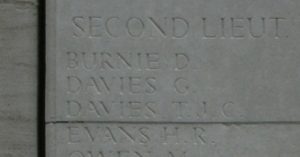
Griffith Davies, Private, 64841, Welsh Regiment. Griffith was born on 20 October 1888, the son of William Griffith Davies and Catherine Davies (nee Vaughan, formerly Evans), of 41, Church Street, Ffestiniog. He left home as a young man and by 1911 was lodging in Swansea, where he worked as a Draper’s Assistant. He then resided at 85, Bigyn Hill, Llanelli prior to the war, where he worked as a Draper. Griffith enlisted at Llanelli on 2 December 1915 into the Welsh Regiment and remained on home service for two and a half years before being drafted to France on 5 May 1918, joining the 9th Battalion, Welsh Regiment, which was attached to 58 Brigade, 19th (Western) Division. The battalion had been decimated during heroic fighting during the German Spring offensive on the Somme, during a heroic rearguard action at Beugny and had then been transferred to the Lys to rebuild. The 19th Division was then hit hard again when the Germans launched the second phase of their offensive along the Lys Valley on 9 April and suffered terrible casualties before being transferred to the peaceful Aisne Sector to rebuild. Unfortunately, the Germans launched the third phase of their spring offensive along the Aisne front on 25 May 1918 and the 19th Division was again caught up in ferocious fighting, suffering horrific casualties. Griffith was taken prisoner by the Germans on 30 May, and brought to Cassel POW Camp in Germany, where he became ill and was hospitalised in the camp hospital. He died as a prisoner of war on 28 September 1918. The 30-year-old is buried in Niederzwehren Cemetery, Germany.
Robert Roberts Davies, Private, 18293, Royal Welsh Fusiliers. Robert was born in 1887, the son of Robert Davies and Margaret Davies (nee Williams), of Derfel, Tanygrisiau. He enlisted at Wrexham into the 16th Battalion, Royal Welsh Fusiliers soon after the outbreak of war. The battalion was raised at Llandudno by the Welsh National Executive Committee from a cadre from the 13th Battalion, joining 128 Brigade, 43rd (Welsh) Division and trained in North Wales before moving to Winchester in the summer of 1915, where the formation became renumbered 113 Brigade, 38th (Welsh) Division. The Division moved to France on 2 December 1915 and moved to the Nursery Sector near Fleurbaix for trench initiation alongside the Guards Division. The Division then held a sector of the line near Cuinchy before marching south to the Somme sector in June 1916 to take part in the assault on Mametz Wood. The first attack on the wood was launched on a two-battalion front on 7 July, but failed, and the Divisional Commander, Sir Ivor Philipps, was replaced before the Division attacked again on a two Brigade front on 10 July 1916. After two days of ferocious hand-to-hand fighting, the wood was cleared up to its northern edge, before the battered Division was relieved. It then took over a section of the front at Hébuterne before moving to the Ypres Salient, and taking over the Canal Bank sector at Boesinghe. The infantry battalions of the Division then began carrying out the normal pattern of rotation in the trenches, four days in the front, four in support and four in reserve, whilst also working on trench improvement, digging new trenches, and also carrying out regular patrols and trench raids. Robert was badly wounded during one such spell in the line and was evacuated to hospital at Calais, where he died of his wounds on 7 December 1916, aged 29. Robert is buried in Calais Southern Cemetery, France.
Griffith Edwards, Private, 55279, Royal Welsh Fusiliers. Griffith was born in 1893, the son of Richard Edwards and Elizabeth Edwards (nee Lewis), of 4, Cambrian Terrace, Tanygrisiau. He had been educated at Tanygrisiau School. Griffith enlisted at Blaenau Ffestiniog into the Royal Welsh Fusiliers early in 1915. He was drafted to France in the winter of 1916-17, joining the 13th Battalion, Royal Welsh Fusiliers, which was attached to 113 Brigade, 38th (Welsh) Division. The division was holding the Canal Bank sector of the line north of Ypres, at Boesinghe, and had moved there following its assault on Mametz Wood in July 1916. The infantry battalions of the Division then began carrying out the normal pattern of rotation in the trenches, four days in the front, four in support and four in reserve, whilst also working on trench improvement, digging new trenches, and also carrying out regular patrols and trench raids. The 13th RWF was in the line, holding the Nile Subsector, on 22 June 1917 when Griffith was badly wounded by shellfire. He died of his wounds that same day. The 24-year-old is buried in Ferme Olivier Cemetery, Ieper, Belgium.
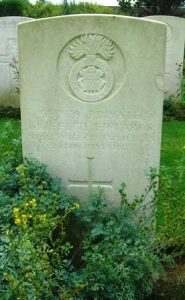
John Pryce Hughes, Lance Corporal, 2517, Royal Welsh Fusiliers. John was born in America in 1889, the son of David Hughes and Ann Hughes. By 1901 the family had moved back to Wales, and lived at Utica House, Tanygrisiau. By 1911 John was living at 20, Bron Mierion, National Street, Tywyn, where he worked as a Printer. He married Mary Elizabeth Griffiths, of Tywyn, early in 1915, after having enlisted into the 7th Battalion, Royal Welsh Fusiliers. The battalion was a Territorial unit, which mobilised for war at Newtown in August 1914, as part of North Wales Brigade, Welsh Division and moved to Conway until the end of the month, before moving to Northampton. In December the Division moved to Cambridge and then in May 1915 to Bedford, where the Division was numbered and the formation became 158 Brigade, 53rd (Welsh) Division. On 19 July 1915 the entire Division sailed from Devonport for Imbros and on 9 August 1915 landed at Suvla Bay. The infantry moved off the beaches into the bush, but due to a lack of maps and no knowledge of the terrain, many of the units became disorientated, and the situation became chaotic. John was killed in action at Gallipoli on the following day, 10 August 1915, aged 26. He is buried in Green Hill Cemetery, Gallipoli.
Hughes, Robert. This man cannot presently be identified, but is possibly:
Robert Hughes, Private, 9785, Royal Army Medical Corps. Robert was the son of Daniel and Mary Hughes of 2, Barlwyd Avenue, Oakeley Square, Blaenau Ffestiniog. He enlisted at Blaenau Ffestiniog into the Royal Army Medical Corps, and was posted to East Africa with the Royal Army Medical Corps. Robert was posted to the 84th General Hospital, at Dar es Salaam, Tanzania. Robert survived the war, but sadly took ill after the Armistice and died of Influenza at the 84th General Hospital on 26 November 1918, aged 25. He is buried in Dar Es Salaam (Upanga Road) Cemetery, Tanzania.
Arthur Jones, Private, 69617, Royal Army Medical Corps. Arthur was born in Manchester in 1889. He was orphaned at an early age and came to live with his uncle, Robert Evan Jones, at Nant Peris, Llanberis, where Arthur was educated. Robert became headmaster at Tanygrisiau Council School prior to the war. Arthur had by then became a newspaper reporter, first for the Herald of Wales at Caernarfon, and then for the Halifax Courier in Yorkshire by 1911. In 1913, Arthur was promoted to a staff position at the Staffordshire Sentinel newspaper. He enlisted into the army soon after the outbreak of war but was rejected as medically unfit. Undeterred, Arthur re-enlisted at Stoke-on-Trent into the Royal Army Medical Corps on 7 October 1915 and was posted to the depot at Aldershot for training before being posted to the 136th Field Ambulance, RAMC, which was attached to the 40th (Bantam) Division. Arthur embarked with the Ambulance at Southampton on 3 June 1916 and disembarked in Le Havre, before the 40th Division moved initially to positions around Lillers before taking over the North Maroc Sector, near Loos, for trench initiation and once acclimatised was left to hold the sector itself over the coming months. The infantry battalions of the Division then began the usual routines of rotating for duty in the trenches: normally four days in the front line; four in support and four in reserve. Late in 1916 the Division moved south to the Somme, and fought at the Battle of the Ancre. The 136th Field Ambulance set up at La Beuvriere, where it remained until moving to Braquemont on 12 October, setting up its dressing station. At the end of the month the ambulance moved to billets in Bruay to rest, then had several more moves before setting up again at Vauchelles Les Quesnoy by 24 November. On 17 December 1916 Arthur was working in a quarry collecting stones to make a bunker when it collapsed on top of him, breaking his pelvis, tibia and fibula and crushing him severely. Barely alive, he was taken to his own 136th Field Ambulance where he died of his injuries that same day. The 27-year-old was buried in La Neuville Communal Cemetery, Corbie, France.
Elias Jones, Private, 16928, Royal Welsh Fusiliers. Elias was born in 1892, the son of Robert Jones and Jane Jones, of Glanrafon, Bodychain, Tanygrisiau. He worked as a slate quarry labourer prior to the war. Elias enlisted into the Royal Welsh Fusiliers at Maesteg soon after the outbreak of war and was drafted to France on 12 May 1915, joining the 1st Battalion, Royal Welsh Fusiliers, which was attached to 22 Brigade, 7th Division. The battalion was in the process of rebuilding following heavy losses at the Battles of Neuve Chapelle, Festubert and at Aubers Ridge, which had just closed when Elias arrived. The 1st RWF spent the coming weeks billeted behind the lines, before moving back into support positions by 7 June and began the usual routines of rotating for duty in the trenches over the coming weeks. On 13 July the 1st RWF relieved the 1/4th Black Watch in the front line facing Rue du Bois and Richebourg-L’avoue to begin a routine tour in the trenches. Elias was wounded here on 16 July 1915 and was evacuated to the 22nd Field Ambulance, where he died of his wounds that same day. The 23-year-old was buried in Vielle Chapelle Old Military Cemetery, but in January 1924 the cemetery was cleared, and he was re-interred in Cabaret Rouge British Cemetery, Souchez, France.
Jones, John H. This man cannot presently be identified, however he reportedly resided at Bod Uchain?
Robert Evan Jones, Sapper, 121735, Royal Engineers. Robert was born in 1886, the son of William Jones and Sarah Jones, of Cwmorthin Terrace, Tanygrisiau. He worked as a slate worker prior to the war. Robert enlisted into the Royal Engineers at Blaenau Ffestiniog and after embarking for France on 29 September 1915 was posted to the 183rd Tunnelling Company, Royal Engineers, which was in the process of forming at Rouen. The Company then moved to Fontaine-lès-Cappy, south of the Somme before moving into the Carnoy-Maricourt area to prepare mines and saps for the forthcoming Somme offensive. The 183rd Tunnelling Company alone placed four mines in the front sector allocated to XV Corps near Mametz and three mines in the front sector allocated to XIII Corps near Carnoy, as well as digging dozens of Russian saps in the front sector allocated to XV Corps, which ran from the British front line to the very edge of the German positions. The Company then moved into the Ypres Salient to begin work on deep dugouts, in preparation for the forthcoming Battle of Messines, which opened on 7 June 1917. In April 1918, the 183rd Tunnelling Company, together with several others, were forced to move from their camps at Boeschepe, when the Germans launched their offensive along the Lys. The units were then put to work on defensive schemes from Reningelst to near Saint-Omer. The fighting had moved away to the Champagne sector by the end of May and the 183rd Tunnelling Company moved to the Rubempre area at the end of July. The company then supported the 38th (Welsh) Division in the Aveluy Sector, until the division launched its assault across the River Ancre on 21 August and began its great drive towards the Hindenburg Line, with the 183rd following the division as it fought its way east. Robert was killed whilst reconnoitring wells for drinking water near Mortho Wood on 8 October 1918. The 32-year-old was originally buried on the battlefield, east of the wood, but his grave was exhumed after the war and he was re-interred in Naves Communal Cemetery Extension, France.
Abel Lloyd, Private, 291479, Royal Welsh Fusiliers. Abel was born in 1897, the son of Griffith Lloyd and Alice Lloyd (nee Jones), of 7, Cambrian Terrace, Tanygrisiau. He worked as a slatemaker prior to the war. Abel enlisted into the 3/7th Battalion, Royal Welsh Fusiliers at Blaenau Ffestiniog on 28 February 1916 and was posted to the Depot at Wrexham. On 10 December 1916 he embarked for Egypt and on 26 December disembarked in Egypt, joining the Infantry Base Depot. Abel was then posted to the 1/7th Battalion, Royal Welsh Fusiliers. The battalion was a Territorial unit, which was attached to 158 Brigade, 53rd (Welsh) Division and had just been evacuated from Gallipoli. The division then joined the EEF, and helped guard the Suez Canal before taking part in operations to drive the Turks out of the Sinai. The EEF then turned its attention onto driving the Turks out of Palestine, and on 26 March 1917 launched its first offensive against the coastal city of Gaza, which guarded the road to Jerusalem. Initial gains during the day were lost when the assaulting divisions lost touch with each other and communication broke down when a thick fog cloaked the battlefield. Abel was killed in action during the assault that day. The 20-year-old has no known grave and is commemorated on the Jerusalem Memorial, Israel.
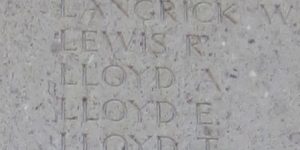
Evan Owen, Private, 290637, Royal Welsh Fusiliers. Evan was the son of Evan and Annie Owen, of Tynllwyn, Tanygrisiau, Blaenau Ffestiniog. He enlisted into the 7th Battalion, Royal Welsh Fusiliers at Blaenau Ffestiniog on 19 September 1914. The battalion was a Territorial unit, which mobilised for war at Newtown in August 1914, as part of North Wales Brigade, Welsh Division and moved to Conway until the end of the month, before moving to Northampton. In December the Division moved to Cambridge and then in May 1915 to Bedford, where the Division was numbered and the formation became 158 Brigade, 53rd (Welsh) Division. On 19 July 1915 the entire Division sailed from Devonport for Imbros and on 9 August 1915 landed at Suvla Bay. The Division took part in heavy fighting over the coming days, then as winter drew in, were subject to terrible conditions, with snow storms and rain so hard at one time that even the bodies of the dead were washed from their graves into the trenches. Evan was evacuated aboard the Hospital Ship Sudan just prior to the Division being relieved, as he had fallen ill. By the time he had re-joined the battalion, from Hospital in Malta, the Division was on the Suez Canal defences, as part of the EEF, taking part in operations to drive the Turks out of the Sinai. The EEF then turned its attention onto driving the Turks out of Palestine, and on 26 March 1917 launched its first offensive against the coastal city of Gaza, which guarded the road to Jerusalem. Initial gains during the day were lost when the assaulting divisions lost touch with each other and communication broke down when a thick fog cloaked the battlefield. Evan was posted as missing, believed killed in action, here on 26 March 1917. The body of the 29-year-old was never identified, so he is commemorated on the Jerusalem Memorial, Israel.
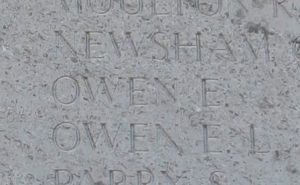
Azariah Phillips, Lieutenant, Royal Flying Corps. Azariah was the son of John and Elizabeth Phillips, of 6, Bowydd View, Trawsfynydd. He originally enlisted into the Army and had been commissioned as an officer in October 1917, before volunteering to train as a Pilot with the Royal Flying Corps, and was posted to Old Sarum, Salisbury for training on the BE2E. On 11 January 1918 Azariah was flying BE2e, Serial A8635 at Salisbury when he collided with a tall wireless mast and hit the ground, destroying the aircraft and suffering terrible injuries. He was rushed to Salisbury Hospital where he died of internal injuries later the following day, 12 January 1918. Azariah was 19 years old and was brought home for burial in Penycefn Cemetery, Trawsfynydd. His brother Robert was killed in Ireland the following year.
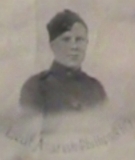
Robert Edward Phillips, Corporal, 40415, Royal Welsh Fusiliers. Robert was the son of John and Elizabeth Phillips, of 6, Bowydd View, Trawsfynydd. He was a shop assistant for Marshall and Snelgrove (now Debenhams), at 16 Marylebone Lane, Oxford Street, London prior to the war. Robert enlisted in London into the Royal Welsh Fusiliers, and was posted to the 3rd Battalion, Royal Welsh Fusiliers at Litherland. In November 1917 the battalion was sent to Limerick, as part of a large British military presence, to attempt to quell the mutinous feelings which had erupted in Ireland. On 24 June 1919 Robert was in his barracks in Limerick, sitting near a comrade who was cleaning his revolver. Unbeknown to its owner, the revolver has a round in one of its chambers, which went off, striking Robert through the shoulder and exiting through his neck. He was taken to the infirmary where he died 20 minutes later, aged 27. His remains were brought home for burial in Penycefn Cemetery, Trawsfynydd, together with his brother Azariah, who had been killed in Salisbury in a flying accident the previous year.
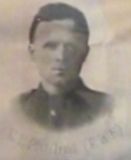
Ellis Pritchard, Private, 546147, Labour Corps. Ellis was born in 1898, the son of Thomas Pritchard and Ruth Wynne Pritchard (nee Evans), of 4, Cwmorthin Road, Tanygrisiau. He worked as a quarryman prior to enlisting into the Royal Welsh Fusiliers on 14 September 1917 and was posted to the 66th Training Reserve Battalion at Kinmel Park. Ellis was already suffering with his health when he enlisted, so he was medically downgraded and posted to the Western Command Labour Centre at Oswestry, to join the Labour Corps. He served with the Labour Corps until 16 April 1918 when he was discharged from the army as medically unfit, due to suffering from heart disease, aggravated by his military service. Ellis returned home to 3, Glanyrafon Terrace, Tanygrisiau, where he died of heart disease on 28 July 1918. The 20-year-old was buried in Bethesda Cemetery, Blaenau Ffestiniog. Ellis is not commemorated by the CWGC. His father, Thomas Pritchard, served with the 7th RWF during the war and died in 1920.
Thomas Pritchard, Company Sergeant Major, 290634, Royal Welsh Fusiliers. Thomas was born in Llanberis in 1871, the son of Hugh and Mary Pritchard. The family moved to Blaenau Ffestiniog soon after his birth. Thomas married Ruth Wynne Evans in 1891 and the couple settled at 4, Cwmorthin Road, Tanygrisiau. Thomas worked as a slate miner prior to the war. He enlisted into the 1/7th Battalion, Royal Welsh Fusiliers at Blaenau Ffestiniog soon after the outbreak of war. The battalion was a Territorial unit, which mobilised for war at Newtown in August 1914, as part of North Wales Brigade, Welsh Division and moved to Conway until the end of the month, before moving to Northampton. In December the Division moved to Cambridge and then in May 1915 to Bedford, where the Division was numbered and the formation became 158 Brigade, 53rd (Welsh) Division. On 19 July 1915 the entire Division sailed from Devonport for Imbros and on 9 August 1915 landed at Suvla Bay. The infantry moved off the beaches across the Salt Lake, under shellfire, into the scrub covered Chocolate Hill, but due to a lack of maps and no knowledge of the terrain, many of the units became disorientated, and the situation became chaotic. After the fighting died down, the winter rolled in, and the men first had to endure torrential downpours, which flooded the trenches, before the snow hit, and many men began falling ill in the terrible conditions. The Division was eventually evacuated from Gallipoli in December 1915, moving to Egypt to join the EEF, and helped guard the Suez Canal before taking part in operations to drive the Turks out of the Sinai. The EEF then turned its attention onto driving the Turks out of Palestine, and on 26 March 1917 launched its first offensive against the coastal city of Gaza, which guarded the road to Jerusalem. Initial gains during the day were lost when the assaulting divisions lost touch with each other and communication broke down when a thick fog cloaked the battlefield. A second attempt to force Gaza was launched on 17 April, which also failed, and the EEF suffered a change in leadership, with Sir Edmund Allenby assuming command, before being re-organised, and a third offensive was launched against a wider front from Beersheba to Gaza on 31 October 1917. This time the Turkish defences were breached, and the road to Jerusalem now lay open and the EEF began to advance north. On 6 November 1917, 158 Brigade launched an attack on the Khuweilfeh Heights, and once secured, the EEF continued its advance into the Judean Hills, the 53rd Division capturing Hebron and Bethlehem, before securing the Jerusalem to Jericho road. Allenby finally made his triumphant entry into Jerusalem on 11 December. The EEF continued its advance north over the coming months until the Turks surrendered, then the 53rd Division moved back to Egypt prior to the men being sent home for demobilisation. Thomas survived the war and returned home to Tanygrisiau, but died of tuberculosis on 14 May 1920. The 49-year-old was buried in Bethesda Cemetery, Blaenau Ffestiniog. Thomas is not commemorated by the CWGC. His son, Ellis, had died in 1918.
Hugh Lewis Roberts, Private, 40954, Royal Welsh Fusiliers. Hugh was born in 1881, the son of Robert Roberts and Margaret Roberts, of Cae Ffridd, Tanygrisiau. He married Florence Davies on 3 September 1913, and the couple lived at Grove House, Llanberis. Hugh worked as a Quarryman prior to the war. He enlisted at Wrexham into the 3rd Battalion, Royal Welsh Fusiliers on 1 July 1916 and was posted to Litherland Camp, Liverpool for training. On 19 November 1916 Hugh embarked for France and joined No 5 Infantry Base Depot at Rouen. On 8 December 1916 he was posted to the 10th Battalion, Royal Welsh Fusiliers, which was attached to 76 Brigade, 3rd Division, but took ill soon after and was hospitalised, suffering from myalgia. Once he had recovered, he was posted back to No 5 Infantry Base Depot on 3 March 1917, and on 16 May 1917 eventually re-joined his battalion at Arras. On 12 June 1917 the battalion moved into the front line at Monchy and on the night of 13/14 June the battalion took part in an assault by 76 Brigade. The Germans counter-attacked on 15 June, but 76 Brigade stood firm and beat off the attack. On the following day the Brigades front line was shelled mercilessly by German artillery. Hugh was wounded in the head and evacuated to the 7th Field Ambulance, where his wound was dressed before he was taken to the 41st Casualty Clearing Station, before being sent to the 5th General Hospital at Rouen. Upon his recovery he re-joined the battalion on 19 October, but within weeks was hospitalised again, suffering from a severe case of Scabies. He was given two weeks leave in December 1917 and upon returning to France was hospitalised again with Scabies. On 9 April 1918 Hugh was posted to the 13th Battalion, Royal Welsh Fusiliers, which was at Bouzincourt Ridge, on the Somme, attached to 113 Brigade, 38th (Welsh) Division. On 22 April 1918 the 13th RWF took part in an operation to capture the high ground at Bouzincourt Ridge, but suffered severe casualties. Hugh had been wounded again, suffering gunshot wounds in the arm, and was evacuated from Rouen aboard the Hospital Ship SS St. Patrick, before being taken to the 3rd Scottish General Hospital, Glasgow. He had his arm amputated, but septicaemia set in, and he died of his wounds on 7 May 1918, aged 36. His remains were brought home for burial in Llan Ffestiniog Cemetery.
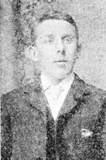
John Roberts, Private, 73203, Royal Welsh Fusiliers. John was born in 1899, the son of William Roberts and Annie Roberts, of Bryn Maes, Tanygrisiau. He enlisted into the Training Reserve as soon as he turned eighteen and was posted to Kinmel Park for training. John was drafted to France early in 1918, joining the 9th Battalion, Royal Welsh Fusiliers, which was attached to 58 Brigade, 19th (Western) Division. The Division wintered in the Cambrai sector, following the closure of the Battle of Cambrai, and was holding a section of the line in the Flesquières Salient. On 21 March 1918 the Germans launched the first of three offensives on to the section of the front running from Flesquières to St. Quentin, and the 19th Division was thrown into desperate fighting as it was pushed back over the coming days. The battered Division was then moved to the Messines sector to rest, but on 11 April became caught up in the second phase of the German offensive, which had been launched along the Lys Valley on 9 April, and again became caught up in desperate fighting. John was taken prisoner at some time during these periods of desperate fighting and was taken to a Prisoner of War camp at Gelsenkirchen, in Germany. Sadly, he died in captivity soon afterwards, on 31 May 1918, probably of sickness. The 19-year-old was buried in Cologne Southern Cemetery, Germany.
World War Two, 1939-1945
Two of the men named in the Chapel Bible fell during the Second World War, however I do not presently know which of the above names belong to them, so if anyone has access to the Bible, to photograph the inscription for me, I would be most grateful.